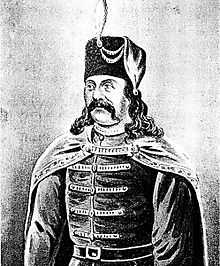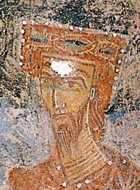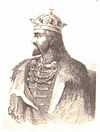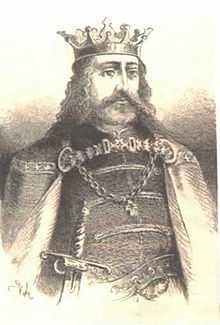List of rulers of Duklja
This is a list of rulers of Duklja.
List of rulers
| Byzantine Empire | First Bulgarian Empire | Holy Roman Empire | Grand Principality of Serbia | Independent |
| Picture | Name | Title | Reign | Notes | Geneaology |
|---|---|---|---|---|---|
| Peter | "archon of Dioklea" | ? | He was an archon of Duklja in the 10th or 11th century. The only information on him is from a seal found in the 19th century, which is decorated on the observe with a bust of the Virgin Mary holding a medallion of Christ and flanked by two cruciform invocative monograms. The text is in Greek letters, saying "Petrou, Archontos Diokleias, Amin" (ΠΕΤΡ(Ο)Υ ΑΡΧΟΝΤΟΣ ΔΙΟΚΛ(Ε)ΙΑ(Σ) ΑΜΗΝ) - Peter, archon of Dioklea, Amen. The seal shows that although Duklja underwent turmoil in the 9th century, the region still continued under Byzantine rule, or if not authority, influence.[1] | ||
 | Jovan Vladimir | Prince | fl. 1000–1016 | Jovan fought to protect Duklja from Bulgarian expansion, making an alliance with Byzantium; Bulgaria however conquered Duklja in 997 and took Jovan Vladimir prisoner. Jovan ruled Duklja as a vassal of the Bulgarian empire until 1016. | CPD: Petrislav |
 | Stefan Vojislav | "Prince of the Serbs"[2] or "of Serbia"[3] toparch of the Dalmatian kastra of Zeta and Ston | 1018–1034 1040–1043 | Overthrew the Byzantine supremacy over Serbs in Duklja; founder of the Vojislavljević dynasty; in 1035 rebelled against the Byzantine Empire, but forced to sign an armistice; went to war again in 1040, which would be continued by his heir and son, Mihailo. Except Duklja, his realm included Travunija with Konavli and Zahumlje. | CPD: Dragomir |
 | Mihailo I | "Prince of Tribals or Serbs" "King of Slavs" | 1050–1077 1077–1081 | Crowned King by the pope in 1077. | Stefan Vojislav |
 | Constantine Bodin | "protosebastos and executor of Dioklea and Serbia"[4] King (titular) | 1081–1085 1085–1091 | Tsar of Bulgaria as Peter III in 1072. | |
 | Dobroslav II | King (titular) | 1101–1102 | Overthrown by Vukan of Rascia and Kočopar. | |
| Kočapar | Unknown | 1102–1103 | Brought to power by Vukan of Rascia. Vassal of the Grand Principality of Rascia. Killed in battle against Zachlumoi. | ||
| Vladimir | Unknown | 1103–1113 | Married daughter of Vukan of Rascia. Vassal of the Grand Principality of Rascia. He was poisoned by his cousin Đorđe. | ||
| Đorđe | Unknown | 1113–1118 | Son of Constantine Bodin. Đorđe was overthrown by Uroš I of Rascia in 1118. | ||
| Grubeša | Unknown | 1118–1125 | Overthrew Đorđe with the help of the Byzantines. | ||
| Đorđe | Unknown | 1125–1131 | Second rule. Vassal of the Grand Principality of Rascia. | ||
| Gradinja | Prince | 1131–1146 | Appointed to Doclean throne by Byzantines after Đorđe's defeat in the second Doclean-Byzantine War. | ||
| Radoslav | Prince | 1146–1148 | Byzantine vassal. Only dynastic member to be mentioned as Prince of Doclea. | ||
| Mihailo II | Prince | 1148–1186 | Byzantine vassal. | ||
Duklja continues as a crownland of Grand Principality of Serbia.
Rulers according to the Chronicle of the Priest of Duklja
The following rulers are mentioned only in the Chronicle of the Priest of Duklja (CPD), written by a Catholic monk of the Cistercian order by the name of Roger (Rudger) for political motive at the request of Croatian Ban Paul Šubić. It was written in two versions - the first one in Split in 1298 while Roger was handling the Archbishop of Split's finances, and the second ca. 1300, while he was the Archbishop of Antivari (Bar).
The chronicle, built round a core written in Slavonic, but added to by a bishop of Bar intent on demonstrating his diocese' superiority over that of Split, is one of the oldest known written sources, but only Latin redactions[5] from the 16th and 17th centuries have been preserved.
Historians have largely discounted it, though it contains material on the early history of the South Slavs. The work describes the Slavs as a peaceful people imported by the rulers of the Goths, who invaded the area in the 5th century, but it doesn't attempt to elaborate on how and when this happened. Furthermore, it mentions Bosnia (Bosnam) and Rascia (Rassa) as the two Serbian lands, while describing the southern Dalmatian Zahumlje, Travunia and Duklja (most of today's Herzegovina, Montenegro, as well as parts of Croatia and Albania) as Croatian lands in the Early Middle Ages - these contradict the Byzantine work De Administrando Imperio and other contemporary sources.
Various inaccurate or simply false claims make it an unreliable source. This work is, as the majority of modern historians think, mainly fictional, or wishful thinking, however, it does give us a unique insight into the whole era from the point of view of the indigenous Slavic population. One of the prime controversies of the Chronicle, lies in the fact that the Antivari Archepiscopate did not exist between 1142 and 1198 - and that is the time Rudger is supposed to have been the Archbishop.
| Name | Notes | Geneaology |
|---|---|---|
| Hvalimir | He held the region of Zeta with its cities and the following županijas: Lusca, Podlugiae, Gorsca, Cupelnich, Obliquus, Prapratna, Cermenica and Budva with Cuceva and Gripuli. | |
| Petrislav | Some historians identify him with Peter of Diokleia (whose seal belong to the 10th or 11th century) which would make Petrislav the earliest ruler whose existence is confirmed by primary historical sources.[6][7] According to the chronicle, after his father's death, the rule was divided among his three sons: Petrislav ruled Zeta, while Dragimir ruled Travunia and Zachumlia (to the west), and Miroslav ruled Podgoria (to the north). After the youngest brother Miroslav died, Petrislav, as the oldest, inherited his land, thus bringing the whole of Duklja (Zeta and Podgoria) under his rule.[8] Petrislav was buried in the Church of the Holy Virgin Mary in Krajina. He was succeeded by his son Jovan Vladimir.[6][7] | |
| | ||
| Dragomir | he ruled Travunia and Hum. At the death of Vladimir, he ruled Duklja for two years, being murdered in 1018 by locals of Kotor. | |
| Dobroslav II | ||
| Mihailo II | ||
| Dobroslav III | ||
| Mihailo III | ||
See also
Notes
References
- ↑ Eric McGeer, Catalogue of Byzantine Seals at Dumbarton Oaks and in the Fogg Museum of Art: The East (continued), Constantinople and environs, unknown locations, addenda, uncertain readings, Dumbarton Oaks, 2005, p. 155, ISBN 0884023095, 9780884023098
- ↑ Scylitzes, 408-9
- ↑ Cedrenus, ed. Bonn, II, p. 526
- ↑ "Jean-Claude Cheynet, „La place de la Serbie dans la diplomatie Byzantine à la fin du XI e siècle“, Zbornik radova Vizantološkog instituta , XLV, Beograd, 2008, 89–9".
- ↑ The legend of Basil the Bulgar-slayer, page 27
- ↑ 6.0 6.1
- ↑ 7.0 7.1 Živković 2009, pp.260–2.
- ↑ Stephenson 2010.
Sources
- Stephenson, Paul (July 2010). "Chronicle of the Priest of Duklja, Chapters 30-35". Translated Excerpts from Byzantine Sources. Paul Stephenson.
- Van Antwerp Fine, John (1991). The Early Medieval Balkans: A Critical Survey from the Sixth to the Late Twelfth Century. The University of Michigan Press. ISBN 0-472-08149-7.
- Živković, Tibor (2006). Портрети српских владара (IX-XII) (in Serbian). Belgrade: Zavod za udžbenike. ISBN 86-17-13754-1.
- Živković, Tibor (ed.) (2009). Gesta Regum Sclavorum (in Latin and Serbian). 2. Belgrade: Institute of History; Ostrog Monastery. ISBN 978-86-7743-075-7.